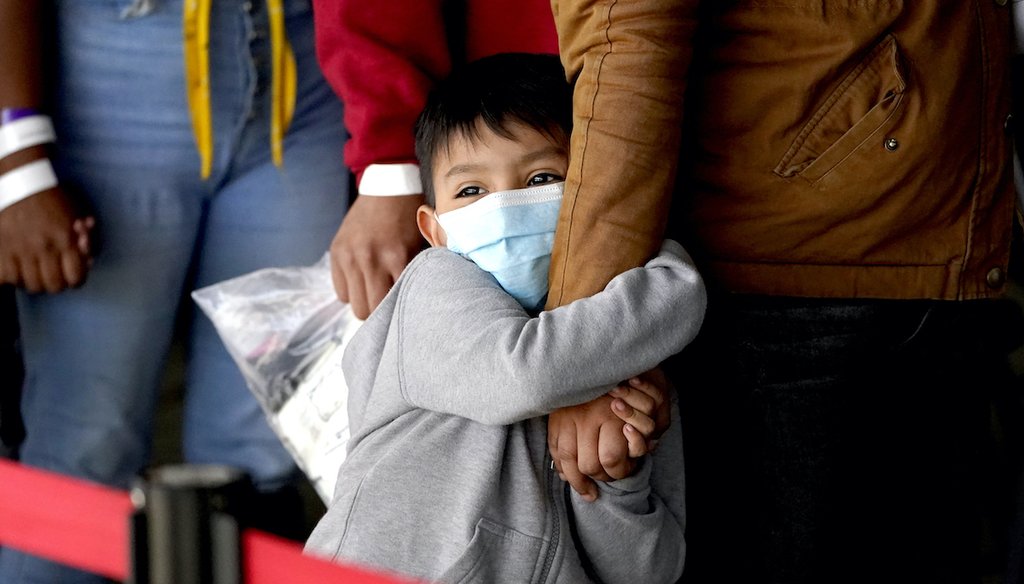Stand up for the facts!
Our only agenda is to publish the truth so you can be an informed participant in democracy.
We need your help.
I would like to contribute

A migrant child holds onto a woman's arm as they wait to be processed by a humanitarian group after being released from U.S. Customs and Border Protection custody at a bus station, March 17, 2021, in Brownsville, Texas. (AP)
If Your Time is short
-
Immigration authorities said they are working with state and local authorities and non-governmental organizations to make sure that all migrants are tested for COVID-19 “at some point during their immigration journey.”
-
Federal health officials said children at emergency influx facilities are tested for COVID-19 every three days.
-
The exact positivity rate among migrants is unknown. There are different categories of migrants being tested at different times and by varying groups across the border. The figures are likely to fluctuate, too.
Overcrowding at southern border facilities has raised concerns that migrants might get sick with COVID-19 since they may not have enough space to safely distance from each other.
Some Republican lawmakers who went to Texas in late March to examine Border Patrol operations have also raised alarms about admitting into the U.S. migrants who are sick. Sens. Ted Cruz of Texas, James Lankford of Oklahoma and others claim that high percentages of people at a border facility were testing positive for COVID-19.
"We also saw a group of children who just today tested positive for COVID-19. The Donna facility alone reports roughly 10% of the individuals being held there are testing positive for COVID-19," Cruz said during a press conference March 26, referring to a processing center in Donna, Texas.
At that same event, Sen. Dan Sullivan, R-Alaska, offered a different take.
"The people coming in who are released immediately almost. They're not tested at all," Sullivan said. "Open borders, no testing for COVID for the southern border."
Sign up for PolitiFact texts
Are migrants arriving at the southern border being tested for COVID-19? Who is testing them?
PolitiFact is unable to independently confirm what is routinely happening in border facilities and across the extensive U.S.-Mexico border. But here’s what we’ve gathered from the departments of Homeland Security and Health and Human Services, the mayor of a border city in Texas, a nonprofit group that helps migrants, and news reports.
Immigration officials say that the U.S. is on pace to encounter more people on the southern border this fiscal year than in the past 20 years.
In the first six months of this fiscal year, which started in October under the Trump administration, Border Patrol agents recorded more than 550,000 encounters with migrants, nearly three times as many as in the same period a year earlier. Most of them were expelled under a public health law invoked due to the coronavirus pandemic.
Another group of migrants entering the country, at official ports of entry, are those who applied for asylum during the Trump administration and were sent to Mexico to wait for a resolution of their cases. The Biden administration suspended the "Remain in Mexico" program and is allowing people to come into the U.S. while they wait for a decision.
Customs and Border Protection personnel do initial inspections for symptoms or risk factors associated with COVID-19 and consult with onsite medical personnel, the U.S. Centers for Disease Control and Prevention, or local health systems as appropriate, the agency said.
Consistent with longstanding procedures for diseases that pass from one person to another, people presumed to be sick with COVID-19 are sent to local health systems for testing, diagnosis and treatment, CBP said in a statement. CBP did not say what happens when a person tests positive, whether that person stays in a hospital to recover or is sent back to a federal facility.
DHS, which oversees immigration enforcement, said it’s working with state and local authorities and non-governmental organizations to make sure that all migrants are tested for COVID-19 "at some point during their immigration journey."
Cities, counties and NGOs handle the vast majority of the testing and any subsequent isolation, while contractors help fill the gaps. They typically use antigen tests, which can provide results within minutes.
Jewish Family Service of San Diego, a nonprofit that helps migrants in California, said that people in the Remain in Mexico program who enter through the California border area are being tested in Mexico by international organizations and again in the U.S. by UC San Diego Health. (Other asylum seekers, not part of that program, are also tested by the San Diego health system, the nonprofit said.)
"All asylum seekers receive health screenings and stay in hotel rooms before travel, following all public health guidelines," said Eitan Peled, a border services advocate with the Jewish Family Service. Once a negative test result is confirmed, a network of groups helping migrants will arrange travel for them to meet their families in the U.S., Peled said.
Asylum seekers in the Remain in Mexico program who enter via Brownsville, Texas, are also tested for COVID-19 in Mexico, said Brownsville Mayor Trey Mendez in a March 6 Facebook post. Those who test positive are quarantined in Mexico and not allowed to cross into the U.S., Mendez said.
In his early-March post, Mendez also said that people entering through Brownsville were all tested by a third-party service. "Depending on the results of this rapid test, they are then administered a secondary test via PCR," Mendez said. "All positives are then instructed by the city to quarantine under CDC guidelines and are offered hotel rooms paid for by charitable organizations and donations."
In a late-March interview with a local TV station, Mendez said DHS had installed tents at a bus station in Brownsville to test migrants.
BorderReport.com, which provides information about people along the U.S.-Mexico border, said in mid-March that migrants in McAllen, Texas, were being tested for COVID-19 through a collaboration between the city and nonprofits.
"Those who test positive for COVID-19 are driven to a special hotel where they are housed and cared for and food is delivered, and volunteers make sure they remain quarantined," BorderReport.com said March 17.
DHS said it is currently testing "100% of noncitizens" who are apprehended or detained "at some point in their immigration enforcement journey."
That includes adults arriving alone whom the Biden administration says it’s expelling based on a public health law. DHS said that adults are tested when they enter the custody of Immigration and Customs Enforcement.
The Biden administration is also expelling families, but many have still been let in. The administration says that’s happened when Mexico doesn’t have the capacity to accept them. Families are mostly tested through state, local, tribal and territorial partners and NGOs "immediately after release" from immigration custody and before they head elsewhere in the country, according to DHS. In some cases, DHS said contractors step in to do the testing.
DHS said unaccompanied children are tested before they are transferred to HHS custody and again when they arrive at HHS emergency influx sites — temporary facilities set up to handle the overflow from state-licensed facilities.
HHS said that children at emergency sites are tested for COVID-19 every three days. Those who test positive are isolated from the others.
There’s no definitive answer available, since there are different categories of migrants being tested at different times and by varying groups across the border. The figures are likely to fluctuate, too.
In mid-March, Bob Fenton, acting administrator of the Federal Emergency Management Agency, which is part of DHS, told lawmakers that "what we are seeing is less than 6% positive right now coming across the border." (CBS News at the time reported that Texas’ seven-day average positivity rate was 7.4%.)
Mendez, the Brownsville mayor, said in early March that the positivity rate for a particular group of migrants entering Brownsville was about 6.3%. "To put it into context," Mendez said, the Texas positivity rate around that time was about 9%.
HHS told PolitiFact that from March 24, 2020, to April 8, 2021, there were 4,857 lab-confirmed COVID-19 cases among the unaccompanied children in permanent and licensed shelters and some temporary facilities in Texas. (Cases identified in other temporary facilities will be reported once that data is gathered, HHS said.)
According to HHS, of the 4,857:
-
4,249 have recovered and moved from medical isolation
-
2,837 who were moved from medical isolation have been discharged to a sponsor
-
608 remain COVID-19 positive and in medical isolation (as of April 8)
"The situation remains extremely fluid and can change rapidly," HHS said in a statement. "We are providing the latest information while working diligently to combat random speculation and rumors."
Our Sources
Twitter, @SenatorLankford tweet, March 26, 2021
Email interview, Health and Human Services - Administration for Children & Families press office, April 5, 2021
Email interview, Customs and Border Protection press office, April 6, 2021
Email interview, Department of Homeland Security press office, April 7, 2021
Email interview, Jewish Family Service of San Diego, April 7, 2021
CBP.gov, CBP Announces Opening of Temporary Processing Facility in Donna, Texas, Feb. 9, 2021
CBP.gov, Southwest Land Border Encounters, Last modified: April 8, 2021
DHS.gov, Statement by Homeland Security Secretary Alejandro N. Mayorkas Regarding the Situation at the Southwest Border, March 16, 2021
DHS.gov, DHS Announces Process to Address Individuals in Mexico with Active MPP Cases, Feb. 11, 2021
C-SPAN, Federal and State Emergency Management Officials on COVID-19 Response, March 16, 2021
CBS News, FEMA chief says COVID-19 positivity rate among migrants is less than 6%, lower than Texas average, March 16, 2021
Health and Human Services, Children Entering the United States Unaccompanied: Section 7, Policies for Influx Care Facilities, published Sept. 18, 2019
PolitiFact, Fact-checking Joe Biden’s claim about families at the border, March 25, 2021
CDC.gov, Interim Guidance for Antigen Testing for SARS-CoV-2, updated Dec. 16, 2020
Rev.com, Senate GOP Press Conference Transcript on Mexico Border Trip March 26, 2021
Twitter, @SenTedCruz tweet, April 5, 2021
Facebook page for Brownsville Mayor Trey Mendez
BorderReport.com, South Texas charity taking in hundreds of released migrants daily, testing them for coronavirus, March 17, 2021
ValleyCentral.com, Q&A: Brownsville mayor speaks on migration influx, March 29, 2021
Kold.com, Tucson nonprofit prepares for second surge of asylum-seekers, published March 1, 2021 updated March 2, 2021






























